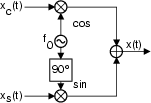L'inviluppo complesso
![]()
![]() t
t![]() = a
= a![]() t
t![]() ej
ej![]()
![]() t
t![]() può ovviamente essere espresso tramite le sue parti reale ed immaginaria:
può ovviamente essere espresso tramite le sue parti reale ed immaginaria:
![]()
![]() t
t![]() = a
= a![]() t
t![]() cos
cos![]()
![]() t
t![]() + ja
+ ja![]() t
t![]() sin
sin![]()
![]() t
t![]() = xc
= xc![]() t
t![]() + jxs
+ jxs![]() t
t![]() .
I segnali
xc
.
I segnali
xc![]() t
t![]() = a
= a![]() t
t![]() cos
cos![]()
![]() t
t![]() ed
xs
ed
xs![]() t
t![]() = a
= a![]() t
t![]() sin
sin![]()
![]() t
t![]() prendono il nome di componenti analogiche di bassa frequenza di
x
prendono il nome di componenti analogiche di bassa frequenza di
x![]() t
t![]() per un motivo presto chiaro. Intanto sviluppiamo8.10 l'espressione del corrispondente segnale modulato:
per un motivo presto chiaro. Intanto sviluppiamo8.10 l'espressione del corrispondente segnale modulato:
| x |
= | |
| = | xc |


Che sia vero anche il viceversa, può essere verificato in modo intuitivo, partendo
da
xc![]() t
t![]() e
xs
e
xs![]() t
t![]() limitate in banda,
e moltiplicandole per coseno e seno. Quest'ultima osservazione ci mostra una
via per sintetizzare un segnale modulato in ampiezza, od angolarmente,
od entrambe le cose, mediante il semplice schema circuitale disegnato a fianco,
che si basa sulla conoscenza delle componenti analogiche di bassa frequenza,
che a loro volta sono ottenibili a partire da
a
limitate in banda,
e moltiplicandole per coseno e seno. Quest'ultima osservazione ci mostra una
via per sintetizzare un segnale modulato in ampiezza, od angolarmente,
od entrambe le cose, mediante il semplice schema circuitale disegnato a fianco,
che si basa sulla conoscenza delle componenti analogiche di bassa frequenza,
che a loro volta sono ottenibili a partire da
a![]() t
t![]() e
e
![]()
![]() t
t![]() .
Restano comunque (per ora) aperti i seguenti problemi:
.
Restano comunque (per ora) aperti i seguenti problemi: